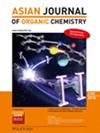In Situ Generated 1‐Naphthylmethyl Radicals from Bis(1‐Naphthylmethyl)tin Dichlorides: Utilization for C−C, C−N, and C−O Bond‐Forming Reactions
IF 2.8
4区 化学
Q1 CHEMISTRY, ORGANIC
引用次数: 0
Abstract
The in situ‐generated 1‐naphthylmethyl radicals from the thermolysis of bis(1‐naphthylmethyl)tin dichlorides combine with persistent organic radicals, 4‐hydroxy‐TEMPO or 4‐oxo‐TEMPO designs C−O bond forming products. Subsequently, the C−N bond occurs when the 1‐naphthylmethyl radicals unite with nitric oxide (NO) under a nitrogen atmosphere. In contrast, the oxidation instead of the addition reaction predominantly happens in the 1‐naphthylmethyl radicals when nitrogen dioxide contains a high oxidation state nitrogen center, i. e., N(IV) used. The by‐product, dodecanuclear organotin cages, with twelve peripheral naphthyl units, could be isolated from the 4‐hydroxy‐TEMPO reaction. Besides, the synthesis of unsymmetrical diarylmethanes RArCH2 (R=1‐naphthyl, 2,4,6‐Me3C6H2, 3‐ and 4‐MeC6H4, phenyl, 4‐ClC6H4; Ar=4‐MeOC6H4, 3,4‐, 2,4‐ and 2,5‐Me2C6H3) in high yields and with good regioselectivity is reported. This new methodology involves the iodine‐mediated thermolysis of bis(arylmethyl)tin dichlorides (RCH2)2SnCl2 and an excess of an arene. This reaction involves homolytic cleavage of Sn−C bonds to give arylmethyl radicals that react with iodine in the presence of SnCl2 to give the corresponding cations, which undergo electrophilic attack on the arene. Functionalised diarylmethanes have wide applications in pharmaceutical, agrochemical, and materials sciences. Alternative synthetic approaches to this class of organic compounds that avoid using a transition‐metal catalyst or a strong Lewis acid are desirable.
求助全文
约1分钟内获得全文
求助全文
来源期刊

Asian Journal of Organic Chemistry
CHEMISTRY, ORGANIC-
CiteScore
4.70
自引率
3.70%
发文量
372
期刊介绍:
Organic chemistry is the fundamental science that stands at the heart of chemistry, biology, and materials science. Research in these areas is vigorous and truly international, with three major regions making almost equal contributions: America, Europe and Asia. Asia now has its own top international organic chemistry journal—the Asian Journal of Organic Chemistry (AsianJOC)
The AsianJOC is designed to be a top-ranked international research journal and publishes primary research as well as critical secondary information from authors across the world. The journal covers organic chemistry in its entirety. Authors and readers come from academia, the chemical industry, and government laboratories.
 求助内容:
求助内容: 应助结果提醒方式:
应助结果提醒方式:


